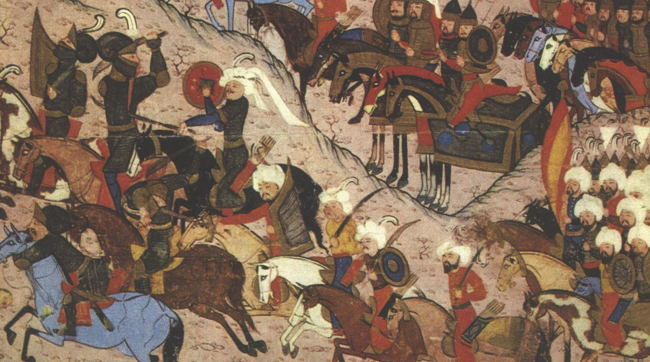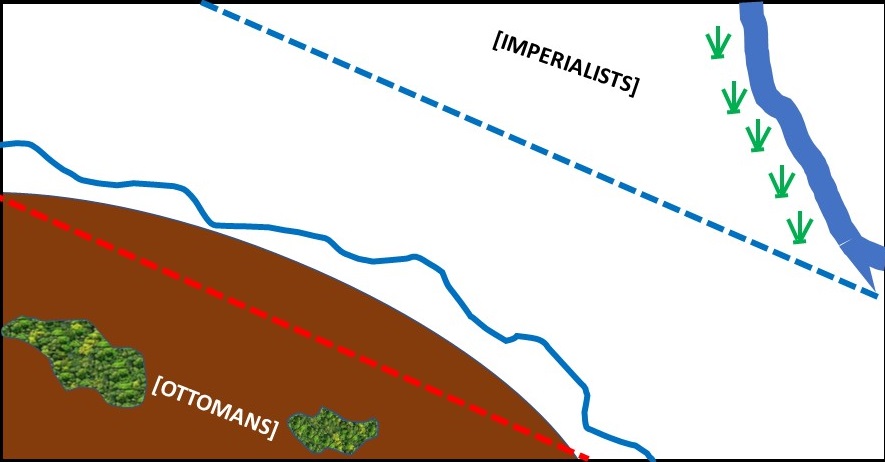The Battle of Mohacs, 1526
An Art de la Guerre (v. 4) Scenario


Suleiman the Magnificent is pushing north toward Buda after his conquest of Belgrade. The once-mighty Hungarians had fallen into disarray after disbanding Matthias Corvinus' Black Army, and failing even to sustain a push to retake Belgrade. Now, the remnants of the Hungarian army are reenforced by German, Spanish, and Papal Italian troops determined to save Christendom.
Suleiman's army has entrenched his massive artillery on high ground above the Danube where the Imperialist forces block his passage to Buda, after a gruelling march under a hot summer sun. If the Christians are defeated, Buda lies defenceless before him. The Sultan cannot believe how pathetic the once-mighty forces of Royal Hungary have become, but he has not faced Emperor Charles's army in the open field before, and the recent siege of Rhodes, although ultimately successful, was hardly a walk in the park. Now he has a chance to test the mettle of the Western troops in the open.
Historically, Mohacs was a major Turkish victory, sending a "wave of terror all over Europe" and setting the stage for decades of conflict between the Holy Roman Empire and the Ottomans. Hungary fell decisively to the Turks, and became a battlefield between the two empires for the next 200 years. (Even today it is remembered as the low point of Hungarian history, as evidenced in the common saying "More was lost at Mohacs," used when something really terrible has happened, to try to put it in perspective .)
The map below shows a standard-sized table. The dark brown area is a gentle series of hills sloping upward toward the bottom of the map. There are some patches of woods on it - difficult and providing cover - but otherwise it is open. There is a marsh along the banks of the Danube - the larger river to the right and top of the map - which is at low water and may be crossed, but is difficult. The smaller stream at the foot of the hill is rough.

Ottomans set up first, anywhere below the red dotted line on the map, with light troops able to set up anywhere on the Ottoman side of the small stream at the foot of the hill. The Imperialists will set up anywhere above the blue dotted line. Rules regarding set-up in proximity to the table edges may be ignored for both sides. Players do not need to orient their commands left-to-right, but may place them in front of each other if desired. Further, commands (including a leader) may be held off-table by either side, to enter by the second turn on any table edge where on-table set-up is permitted. Location of such commands in relation to the map should be indicated in the battle plan.
Note that neither side has a camp - historically, the Ottomans were on the march and had not yet set one up, and the Imperialist's camp was off-table behind them, close to Mohacs. Neither was significant in the battle.( Note that forces have been adjusted for play balance, since the Hungarians, refusing to wait for nearby reenforcements, were historically well below strength. This scenario posits the early arrival of those reenforcements, in the interests of a more balanced game.)
Command: 4 leaders, +7 (35)
Kapikulu: 2 Heavy Cavalry Bow Impact Elite (28)
Sipahis: 8 Heavy Cavalry Bow (88)
Akinjis and Turcomans: 6 Light Cavalry Bow (36)
Rumelian Cebelu: 4 Light Cavalry Impact (24)
Rumelian Cebelu: 6 Heavy Cavalry Impact (60)
Janissaries: 6 Medium Swordsmen Firearm Elite (66)
Voynuks: 3 Heavy Swordsmen Polearm (27)
Iayalar Fanatics: 2 Medium Swordsmen Impetuous Elite (16)
Azaps: 4 Bowmen (28)
Azaps: 1 Light Infantry Bow (4)
Azaps: 4 Light Infantry Firearm Elite (20)
Levy: 3 Levy (9)
Cannon: 3 Heavy Artillery (30)
Fortifications: 9 UD (3)
TOTALS: 52 Units, 474 Points
Commmand: 4 Leaders, +4 (20)
Hungarian Nobles: 10 Heavy Knights Impact (130)
Wallachian Light Horse: 5 Light Horse Bows (30)
Italian/Balkan Light Horse: 4 Light Horse Firearms (30)
Hungarian Cavalry: 4 Light Horse Impact (28)
Landsknecht and Spanish Foot: 6 Pikemen (66)
Papal Infantry: 3 Pikemen mediocre (24)
Imperial Arquebusiers: 3 Handgunners (21)
Spanish Arquebusiers: 3 Handgunners Elite (24)
Landsknecht Crossbows: 4 Crossbowmen Pavise (32)
Landsknecht Zweihanders: 2 Heavy Swordsmen Polearms (18)
Balkan Archers: 3 Light Infantry Bows Elite(15)
Landsknecht Crossbows: 4 Light Infantry Crossbows (16)
Cannon: 1 Light Artillery (6)
Hungarian Militia: 4 Levy Impetuous (16)
TOTALS: 56 Units, 476 Points
Flank marches and ambushes by the Imperialists are not permitted. The Ottomans may perform a flank march if they wish, as they did so historically. The Ottoman fortifications represent their habit of using mantlets and chains between batteries in the center of their formation. These should be deployed in front of and between artillery units.
Ottoman Voynuks and Landsknecht Zweihanders are both rated with Polearms, which are effective against cavalry in the rules as written. For this period, they will also be treated as 2-Handed Weapons, as they were also very effective against pike formations and other foot, being a mixture of halberds, two-handed swords, sword-and-buckler, and similar weapons.
There is no nuance to the victory conditions here: the winner must break their opponent's army. In the case of a tie, however, the Imperialists will win - the Ottomans are the attacker for this scenario.